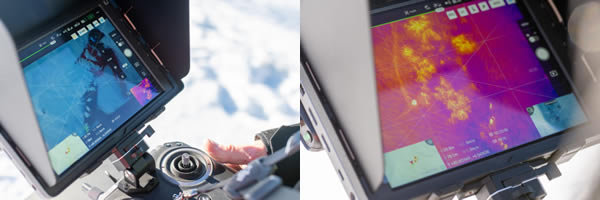 2020 Avalanche News
2020 Avalanche News
French Ski Area Using Drone To Help Save Lives
This winter Les3Vallees in the French Alps will have access to a high-powered drone that has already proved its worth in avalanche and mountain rescues.
19th October 2020
The drone was tested last season in the Belleville Valley ski resorts of Val Thorens, Les Menuires and St Martin de Belleville. It helped save precious time in an avalanche rescue in Les Menuires in February and a huge mudslide this spring in Vallée des Encombres.
It was the idea of a professional drone pilot, Olivier Gardet, who is also the Technical Director of slope services in the Belleville Valley resorts.
The drone can operate in most weather conditions: snow, rain and winds of up to 70km an hour. It’s grounded only by very high winds and cold misty weather when the mist freezes to the drone, making it too heavy and unstable to fly.
Officials say the speed with which it can be deployed and get to the scene of an avalanche or accident – especially if the terrain is difficult – could well save lives. “When a call comes in they will send it out from the ski patrol office in Les Menuires,” said Alix Ostyn from the Val Thorens Tourist Office.
“So, for example, if something is happening in Val Thorens it can be up the slope in a couple of minutes via snowmobile. Then they’ll fly it out to scope the terrain and see what’s happening. Basically it’s used to shorten decision time in emergencies and crises and also to help evaluate areas that are a little tougher to reach so they don’t send in men immediately. They can look and decide what to do.”
The drone has two cameras. One has a 180-times zoom, good enough to identify individuals 3km away. The other has thermal imaging. It can detect people partially buried under avalanche debris, though not those who are fully beneath the surface. A simulation has been carried out with a volunteer playing the victim.

There is also a loudspeaker which lets the drone pilot back at the take-off position to speak to people on the ground. The hope is that at some stage in the future the drone will be able to carry a walkie-talkie radio which could be dropped to an injured skier, for example, to allow two-way communication.
The drone proved its worth last winter when it was sent up to inspect a small avalanche in Les Menuires in February. Olivier Gardet was contacted by a ski instructor who told him of another slide in the Masse area of the resort above the Dame Blanche piste. He sent the drone over to take a look and the camera picked up a skier trying to dig someone out of the avalanche.
“He coordinated the ski patrol from a distance from what he saw on the zoom camera and managed to steer them directly to the right spot, give them details and also help them take a safe route out of the avalanche to evacuate the victim,” Alix Ostyn said. “In the end they saved precious time throughout the whole operation.”
Other uses include checking for potential avalanche risk areas before opening slopes, and maintenance checks and inspection of lifts.
There’s only one drone so far in the Belleville Valley, and three pilots, including one who works the night shift. The aim is to train three or four more pilots this season to guarantee 24/7 coverage. This coming season it will be available not only to ski patrollers but to lift operators, the police and local authorities across the valley.
 |
www.avalanche-center.org |
 |